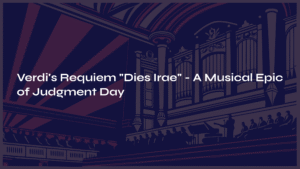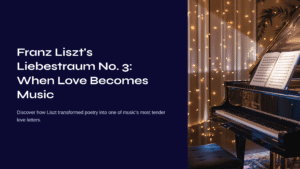Table of Contents

When Silence Begins to Speak
Some music stops time from its very first note. Mahler’s Symphony No. 5, Fourth Movement Adagietto is precisely such music. When all winds and percussion fall silent, leaving only strings and harp to whisper their secrets, I find myself holding my breath. It’s as if I’m eavesdropping on someone’s most intimate confession, feeling a tremor that runs deeper than sound itself.
The moment this music begins to flow, the world starts spinning to a different rhythm. The urgent pace of daily life dissolves, replaced by an awareness of each note’s weight, each harmony’s significance. Though lasting barely ten minutes, within this span we encounter eternity itself.

Summer 1902: Love Born by Wörthersee
Gustav Mahler completed his Fifth Symphony between 1901 and 1902 at his villa overlooking Austria’s Wörthersee. The Fourth Movement Adagietto was born during his passionate courtship of Alma Schindler. When it premiered in Cologne in 1904, audiences were bewildered—this was music beyond their understanding.
But Mahler already knew. This music would endure time itself. Though “Adagietto” means “little Adagio,” the emotional magnitude contained within is anything but small. He often allowed this movement to be performed independently, knowing it could tell a complete story without the symphony’s broader context.
Mahler’s performance markings reveal his deepest intentions: “espressivo,” “seelenvoll” (soulful), “mit innigster Empfindung” (with the most heartfelt sentiment). These aren’t mere performance instructions—they’re pleas to pour one’s soul into every phrase.

A Ternary Narrative Painted in Strings and Harp
First Section – The Tentative Beginning of Confession
The opening in F major feels like someone gathering courage to speak. The melody begins with three ascending eighth notes—a gesture quintessentially Mahler in its yearning quality. This pianissimo opening immediately draws listeners into a quiet, interior space.
As the violin carefully presents the melody, other strings embrace it harmonically. The harp’s arpeggios pulse like a trembling heartbeat. In this section, I always think of first love’s confession—urgent yet anxious, beautiful yet aching.
Second Section – Passionate Development
Beginning at measure 39, the middle section is marked “Fließender” (flowing), ushering in a new emotional landscape. The modulation to G♭ major transforms the music into something more passionate, as if the beloved has accepted the confession and now reveals their own heart more boldly.
Here Mahler takes harmonic risks, wandering through E major and D major, surprising our ears. Unexpected chord progressions emerge, musically painting love’s complex and unpredictable emotions. It feels like wandering through an emotional storm.
Third Section – Transfigured Recapitulation and Climax
The final section begins at measure 72 with the opening theme’s return, but now reaching an entirely different dimension. The moment around measure 95 when the violins soar into their highest register, building to fortissimo, represents the movement’s pinnacle—as if all emotions converge and explode into one transcendent moment.
Then comes the stillness. The final F major chord feels like a soul finding peace after accepting everything. In just over ten minutes, we experience every stage of love.

The Traces This Music Left in My Heart
Whenever I hear this music, I lose all sense of time. Daily noise fades away, leaving only the trembling of strings and harp’s resonance. In that moment, I understand: this is what true love feels like. An emotion where ineffable longing and beauty coexist.
Especially when recalling scenes from Visconti’s “Death in Venice” where this music flows, I’m struck anew by music’s narrative power. Visconti perfectly captured this music’s duality of life and death, love and loss.
Before this music, I always feel humbled. That humans can create such beautiful sound, and that this sound can cross a century to move my heart today, feels nothing short of miraculous.

Suggestions for Deeper Listening
First, listen to this music in the quietest space possible. The Adagietto’s delicate dynamics reveal their true character only when experienced without external noise. The opening pianissimo is so soft it demands complete attention.
Second, compare interpretations by different conductors. Karajan’s sensuous approach, Bernstein’s dramatic interpretation, and contemporary conductors’ fresh perspectives—the same score tells completely different stories under different batons.
Third, listen with awareness of the music’s structure. Feel how each section of the ternary form expresses different emotions, and how those emotions create one complete narrative. Pay special attention to your feelings during the climactic moment around measure 95.

A Language of Love That Transcends Time
Mahler’s Adagietto transcends mere music to become a complete language—translating into notes every aspect of love that words cannot express. And this language speaks to us still, across time and space.
That music born in 1902 by Wörthersee continues to move hearts in 2025 demonstrates art’s true power. Love transcends eras, and authentic emotion always resonates. Mahler’s musical confession to Alma has become the property of all lovers worldwide.

Next Destination: Dvořák’s Slavonic Dance Op. 46, No. 8
After experiencing Mahler’s profound inner world, let’s journey to music of completely different character. Dvořák’s Slavonic Dance Op. 46, No. 8 offers attractions opposite to Mahler’s personal confession.
Beginning in G minor, this dance draws from the Czech folk dance “Furiant.” If Mahler’s Adagietto was an intimate dialogue between two souls, Dvořák’s work resembles a village square celebration. Passionate, energetic rhythms and melodies that shift from melancholy to sudden jubilation naturally move the listener’s body.
The lyrical melody appearing in this piece’s middle section offers beauty different from Mahler’s depths—simple yet genuine, unadorned yet warm. It represents a perfect transition from personal love confession to communal joy, from inward reflection to outward celebration.
Hearing these two works consecutively reveals classical music’s emotional spectrum. One stops time; the other makes time dance.
When you next hear this music, close your eyes and imagine: summer 1902, in a small room overlooking a lake, a man creating the most beautiful gift for his beloved. And that gift has traveled through time to touch your heart now. This is music’s magic.



